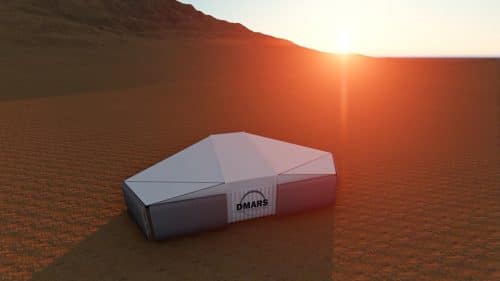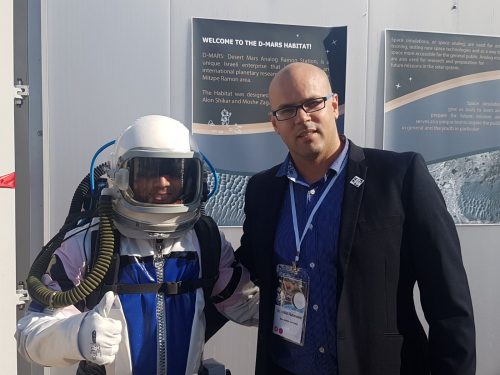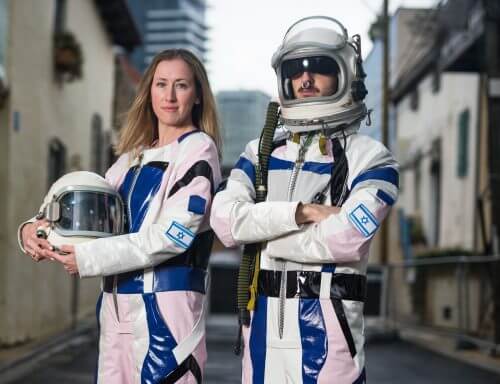6-8 people selected for the mission will be enclosed in a facility in the Mitzpe Ramon area that resembles the planet's environment * For the project, a blue-white spacesuit was developed in collaboration with the Israel Space Agency and the fashion designer Alon Livna

Next month (February) a first-of-its-kind facility will be built in Israel that simulates life on Mars. The project's establishment team is headed by Dr. Hillel Rubinstein from the D-MARS project, a post-doctoral student from Ben-Gurion University of the Negev, under the guidance of the vice president and dean for research and development, Prof. Dan Blumberg.
The D-Mars project is a unique Israeli initiative to establish an international imaging center for planetary research, in the Mitzpe Ramon area, which aims to promote space exploration in Israel in particular and science and technology in general. This is by creating a template and infrastructure to be used for the purposes of academic research, development of technologies in industry and as a methodical means for various educational programs.
For these simulations, an analog research structure known as Habitat is currently being planned as part of a course at the Technion's Faculty of Architecture that deals with the design and construction of space environments and brings together students from aeronautics, mechanics, architecture, computer science, and more. The goal is to build the building in early February 2018 in an isolated desert area near Mitzpe Ramon. The habitat, which is planned and designed inspired by the developments of space agencies in the world, will house about 6-8 people to perform imaging tasks for several days to weeks and will be the cornerstone of the future imaging facility. The first details about the project and the Bitat facility were revealed these days As part of the Israeli Space Week.
Mitzpe Ramon is considered one of the unique sites in the world that simulate conditions relatively close to the conditions prevailing on the surface of Mars. The region is similar to Mars in many respects such as soil structure, geology, aridity, appearance and isolation. The environment provides a combination of analog elements for space simulations, which is difficult to find in other parts of the world.

"The temperature on the surface of Mars ranges from 35 degrees to minus 140 degrees and the different conditions of gravity and atmosphere there are one third than on the surface of the Earth" explains Dr. Rubinstein "It is not possible to exist without supporting aids on the surface of Mars, the type of movement is a light jump from place to place and the exposure to high radiation . The astronauts who reach Mars will move on the surface of the planet in suits that will have all the life support systems in them and will carry out research in the field, which requires suits that allow movement and fine motor movements."
For the project, the Israel Space Agency collaborated with fashion designer Alon Livna to design three space suits. According to Minister of Science and Technology Ofir Akunis, "This is another creative way to make the field of space accessible to the general public in an interesting and different way. I invite the public to be impressed by the suits and the simulation of Mars as part of the Israel Space Week events."
The suits will be used by the six astronauts when they leave the life support structure to conduct field research, similar to the daily routine on the surface of Mars. The suit will simulate a response to the needs of astronauts and the limitations of movement in space such as temperature, radiation, and dust and the suit that will be designed will be adapted to a helmet, gloves and special shoes.
The materials for the suits were ordered from a company in the USA that manufactures for NASA, this is because the suit has to meet very strict conditions of impermeability, ventilation and contains fasteners and technological elements that are specially produced abroad. The challenge was to obtain the professional fabrics and materials in the colors Livna chose for the design, which are purple, pink and light blue, and were therefore produced especially for this project.
Space simulations are a developed field in the global space industry and are used to train future astronauts and make space accessible to the public. The simulation makes it possible to perform experiments by simulating the environment and the accompanying conditions. The uniqueness of the habitat is that it uses the resource of the unique desert environment in a non-offensive way. The various simulations that will be carried out in the facility simulate space missions carried out on Mars and the simulated astronauts will wear space suits when leaving it and their daily routine will be managed according to the procedure in a real mission.

In the world there are a small number of such centers owned by space agencies, industrial companies and educational institutions. Establishing such a center in Israel will place it at the forefront of space research. In addition, the uniqueness of the Israeli facility is that it offers itself to many audiences, while utilizing the resource of the unique desert environment in a non-offensive way.
The D-Mars team has several upcoming goals: the launch of the first analog mission in Israel on February 15-18, 2018, which will be carried out by team representatives in cooperation with the Austrian Space Forum, a national body that includes over 20 countries and specializes in analog missions. Further to this task, in April of this year, the concluding project of the "School for the Training of Young Astronauts" program will be carried out, a year and a half program at the Davidson Institute funded by the Space Agency and the IKA Foundation, which aims to study core issues and acquire tools in the field of space exploration for high school students. The two activities are related because the staff members who first simulate the task are the student educators who will be running the student task.

One response
A solution to the ballistic problem